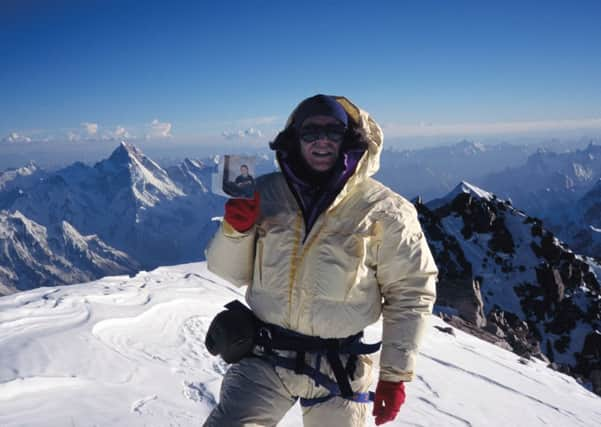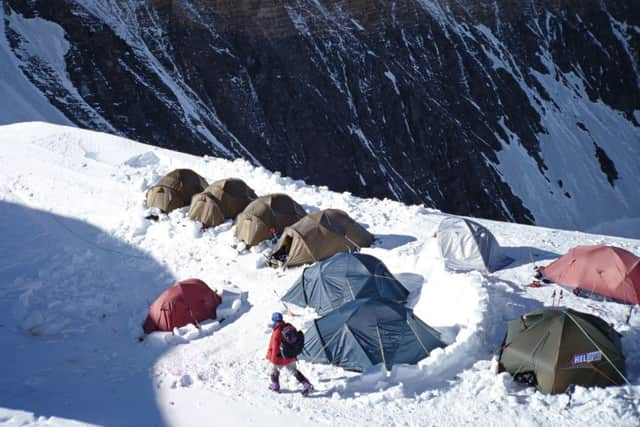Alan Hinkes: Into the death zone


My head ached and my body felt like it was being crushed in a vice. Climbing at extreme altitude is agony. Torture. Yet, even through that haze of suffering, my oxygen-starved brain was aware of the intense seriousness of the situation. No celebration was due yet. I was completely alone on the summit of K2, the world’s second highest and possibly hardest mountain. Now I had to get down.
Some of the world’s best climbers have died descending K2. Many have been killed in good weather, with optimum conditions and in daylight. It was now between 6.30 and 7pm and the light was already fading. I would be descending in the dark.
Advertisement
Hide AdAdvertisement
Hide AdI had to keep reminding myself, ‘I must get down in one piece...No mountain is worth a life, or a finger or toe to frostbite...Returning from a expedition is a success. The summit is only a bonus’. I had to concentrate on the descent back to the world, back to my daughter Fiona.


As the sun dropped and the temperature plummeted even lower, K2 began to cast a huge triangular shadow across the Earth. The temperature was -40C and in the bitter cold I realised frostbite was a real danger. I checked my headtorch and, drawing on many years of mountaineering experience, started my descent.
It had been the culmination of three consecutive years’ attempts on what’s known as the Savage Mountain. To a mountaineer, it is a glittering prize, much more difficult than Everest. Although it is only 200m lower, it is steeper with more technical climbing, worse weather, avalanches, rock fall and a more arduous approach. Success equates to achieving the gold medal in mountaineering. Everest is the highest – but not really the first prize.
My first chance on K2 came in 1993. We were a lightweight team of four and made good progress acclimatising and pushing up the mountain. After three weeks, two of us were preparing for a summit bid. Two climbers from another expedition had gone to the top the previous day and we expected to meet them coming down. We came across only one. He was struggling to move, stumbling along a less steep section of the climb. His friend and climbing partner had already collapsed and fallen, gone, never to be found. It was a simple decision to abandon the ascent and rescue the stricken climber.
Advertisement
Hide AdAdvertisement
Hide AdA year later I made another attempt, this time with a US expedition to the North Face on the Chinese side. Very few people attempt K2 from the north – it is one of the most remote places on our planet. After an extraordinarily circuitous trip, involving several flights through Tibet and China and a long trek carrying all our loads, we established Base Camp. The weather was better than usual and at times was too good, the heat of the sun in the clear sky melting out rocks and causing serious stone fall like incoming mortar fire. There were numerous avalanches, so although the weather was fair, conditions on the mountain were lethal.
I had a close shave at 6,000m. Lying inside my small tent, on top of my sleeping bag, I heard the roar and vibration of an approaching avalanche. Immediately I dived out and clung desperately to the to the rope fixed at the back of the ledge as a safety handrail. Simultaneously I tried to flatten myself against the ice wall as the avalanche poured over me like wet concrete. Its force was sucking me off the ledge and I was drowning under the wet mass. The tent was completely flattened beneath two metres of snow and rock-hard ice blocks; I was lucky to be alive. Yet I was unable to move, buried thigh-deep in snow that had set like concrete. This was a bit serious, as I was clad only in my underpants. What an ignominious way to die, I thought, frozen to death in his Y-fronts. Luckily for me, two of my teammates on a nearby ledge were unharmed and were able to dig me out quickly, retrieving my boots and clothes from the tent before I suffered frostbite or hypothermia. In retrospect it was a serious incident and I was lucky to have survived although it was peculiarly funny.
In that far-flung corner of the world we believed we had the mountain to ourselves, so we were surprised when a Spanish-Italian teamed turned up. They were a strong team and we were soon climbing together. On one sortie, one of the Spanish climbers pulled on some loose rock or an old rope and fell about 50m, tumbling down a sloping rocky section of the route. He stopped just above me, groaning and holding his arm, which seemed to be broken. As I went to his aid, one of his mates carried on up the mountain. I sat with him, and then helped him down to another of his teammates and they continued down to Base Camp together. By now, my team had had enough and my attempt for the summit would have to be made solo.
I spent another 11 nights alone, above 6,800m, trying for the top. When I reached a tiny ledge at 8,100m I let two Spanish climbers squash into my tiny tent with me. We would make a summit bid together. The final 500m is mostly an exposed hanging glacier of steep ice and snow. I was apprehensive because it looked, and felt, very unstable.
Advertisement
Hide AdAdvertisement
Hide AdAfter climbing part of the way up, I turned back. The two Spaniards carried on. The slope did indeed avalanche. One died, the other survived, but was badly frost bitten and had all his toes and fingers amputated.
However, I refused to let any such fatalities and stories of suffering put me off. Some people have accused me of being obsessed with K2, but I put it down to true Yorkshire grit. I was absolutely determined to get up it.
In 1995, after recovering from a serious leg injury, I teamed up with British climber Alison Hargreaves and we set off together to join the American K2 expedition. Alison was an old friend and we trekked for 12 days to base camp where the American team, lead by Rob Slater, was well established and theoretically three weeks better acclimatised than either of us.
After a couple of weeks getting a feel for the conditions on the mountain, we changed partners. Alison teamed up with Rob and I started climbing with university professor and great character Richard Celsi.
Advertisement
Hide AdAdvertisement
Hide AdThe Savage Mountain felt like an old friend, although I was starkly aware of the dangers it posed and knew that I mustn’t get complacent. A good weather window was opening and I knew I had to go for it. Richard had to retreat but I pushed on alone to the shoulder at 8,000m. I was well aware that if the weather deteriorated I could become trapped and quickly perish. The frisson of real danger seemed to keep my mind crystal clear. I knew that I had to seize the opportunity in the benign conditions and grab the big prize – K2’s summit.
I knew it could be a 10-hour climb to the top and another three to five hours back down, so I planned to set off before dawn. As I prepared alone for my summit push, a four-man team from a Dutch expedition turned up.
In the early hours of July 17 it was close to 3am by the time I had warmed my boots and started to function, setting off in the rarefied, gin-clear, painfully cold air.
All four of us co-operated and fixed a thin rope in the steep icy couloir known as the Bottleneck – a spooky, perilous gully overhung by a hideous serac of glistening blue-white ice which towers like a malevolent Beachy Head or White Cliffs of Dover. A series of steep ice bulges eventually led to a final airy snow ridge with a sensational 3,000m drop directly to Base Camp.
Advertisement
Hide AdAdvertisement
Hide AdBy now it was nearly 6pm. I had been struggling up for more than 15 hours, taking huge risks. It would soon be dark. On the summit I managed to pass my camera to one of the Dutch climbers for a photo of myself with a photograph of my daughter Fiona, before the others left without a word.
However, I was glad. I was alone. I had the summit of K2 to myself while its stupendous looming shadow, cast in the setting sun, stretched to and above the horizon.
Usually it is best to spend only a few minutes on a summit such as K2’s. Linger too long at extreme altitude and you will die. I must have been there at least 45 minutes, perhaps nearly an hour, trying to appreciate the most inhospitable spot on the planet.
As nightfall enveloped me, I tore myself away and began the steep descent. Fortunately I am pretty confident on descents and reached my bivouac on the Shoulder at around 10pm. Exhausted, I crawled inside.
Advertisement
Hide AdAdvertisement
Hide AdAlone in my tent in the death zone darkness, I said, “Thank You” out loud to some unspecified greater presence.
8000 Metres – Climbing the World’s Highest Mountains by Alan Hinkes is published by Cicerone priced £25. To order a copy from the Yorkshire Post Bookshop call 01748 821122.
Alan Hinkes: The highest achievement
Alan Hinkes first took up rock climbing at Northallerton Grammar School. Bitten by the mountaineering bug, he conquered peaks in the Alps, before graduating to the Himalayas.
In 2005 after successfully completing ascents of the likes of Everest, K2 and Lhoste, he became the only Briton to climb all 14 8,000m peaks – the highest mountains in the world.
As fellow Yorkshireman Brian Blessed says in the foreword to the book, “His staggering achievement is a clarion call to all who wish to fulfil their dreams. He bellows: ‘Nothing is impossible’. “